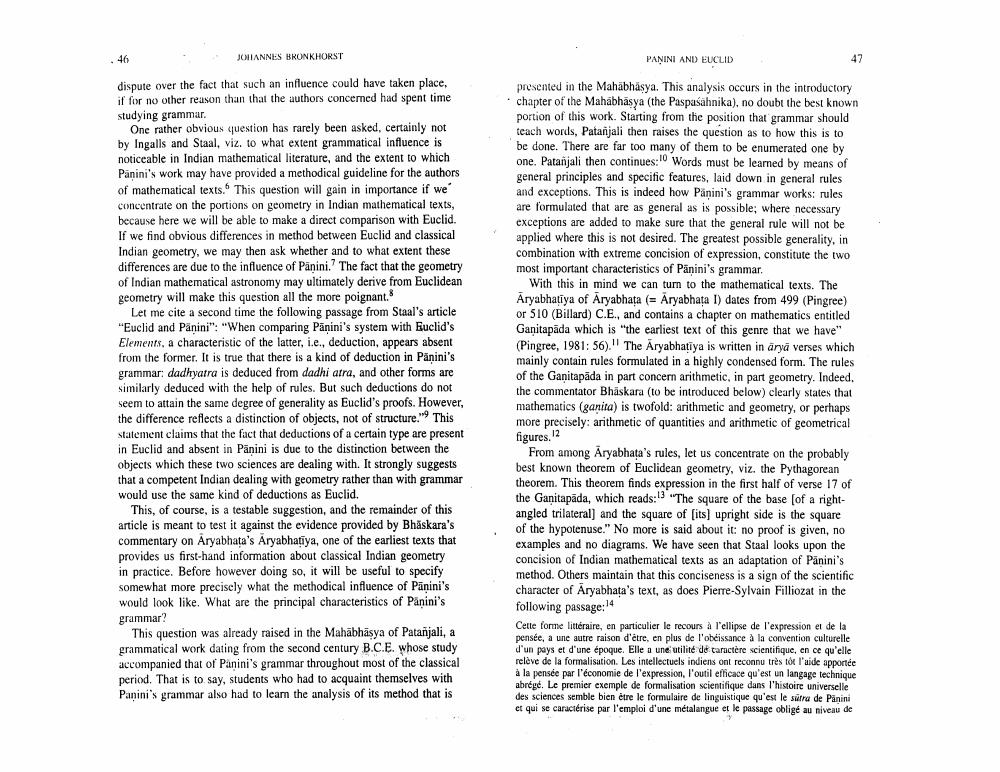Book Title: Panini And Euclid Reflections On Indian Geometry Author(s): Johannes Bronkhorst Publisher: Johannes Bronkhorst View full book textPage 3
________________ JOHANNES BRONKHORST dispute over the fact that such an influence could have taken place, if for no other reason than that the authors concerned had spent time studying grammar. One rather obvious question has rarely been asked, certainly not by Ingalls and Staal, viz. to what extent grammatical influence is noticeable in Indian mathematical literature, and the extent to which Panini's work may have provided a methodical guideline for the authors of mathematical texts. This question will gain in importance if we concentrate on the portions on geometry in Indian mathematical texts, because here we will be able to make a direct comparison with Euclid. If we find obvious differences in method between Euclid and classical Indian geometry, we may then ask whether and to what extent these differences are due to the influence of Panini.? The fact that the geometry of Indian mathematical astronomy may ultimately derive from Euclidean geometry will make this question all the more poignant. Let me cite a second time the following passage from Staal's article "Euclid and Panini": "When comparing Panini's system with Euclid's Elements, a characteristic of the latter, i.e., deduction, appears absent from the former. It is true that there is a kind of deduction in Panini's grammar: dadhyatra is deduced from dadhi atra, and other forms are similarly deduced with the help of rules. But such deductions do not seem to attain the same degree of generality as Euclid's proofs. However, the difference reflects a distinction of objects, not of structure." This statement claims that the fact that deductions of a certain type are present in Euclid and absent in Panini is due to the distinction between the objects which these two sciences are dealing with. It strongly suggests that a competent Indian dealing with geometry rather than with grammar would use the same kind of deductions as Euclid. .46 This, of course, is a testable suggestion, and the remainder of this article is meant to test it against the evidence provided by Bhaskara's commentary on Aryabhata's Aryabhatiya, one of the earliest texts that provides us first-hand information about classical Indian geometry in practice. Before however doing so, it will be useful to specify somewhat more precisely what the methodical influence of Panini's would look like. What are the principal characteristics of Panini's. grammar? This question was already raised in the Mahabhāṣya of Patanjali, a grammatical work dating from the second century B.C.E. whose study accompanied that of Panini's grammar throughout most of the classical period. That is to say, students who had to acquaint themselves with Panini's grammar also had to learn the analysis of its method that is PANINI AND EUCLID 47 presented in the Mahabhäṣya. This analysis occurs in the introductory chapter of the Mahabhāṣya (the Paspaśähnika), no doubt the best known portion of this work. Starting from the position that grammar should teach words, Patanjali then raises the question as to how this is to be done. There are far too many of them to be enumerated one by one. Patanjali then continues:10 Words must be learned by means of general principles and specific features, laid down in general rules and exceptions. This is indeed how Panini's grammar works: rules are formulated that are as general as is possible; where necessary exceptions are added to make sure that the general rule will not be applied where this is not desired. The greatest possible generality, in combination with extreme concision of expression, constitute the two most important characteristics of Panini's grammar. With this in mind we can turn to the mathematical texts. The Aryabhatiya of Aryabhata (= Aryabhata I) dates from 499 (Pingree) or 510 (Billard) C.E., and contains a chapter on mathematics entitled Ganitapada which is "the earliest text of this genre that we have" (Pingree, 1981: 56). The Aryabhatiya is written in äryä verses which mainly contain rules formulated in a highly condensed form. The rules of the Ganitapada in part concern arithmetic, in part geometry. Indeed. the commentator Bhaskara (to be introduced below) clearly states that mathematics (ganita) is twofold: arithmetic and geometry, or perhaps more precisely: arithmetic of quantities and arithmetic of geometrical figures, 12 From among Aryabhata's rules, let us concentrate on the probably best known theorem of Euclidean geometry, viz. the Pythagorean theorem. This theorem finds expression in the first half of verse 17 of the Ganitapada, which reads:13 "The square of the base [of a rightangled trilateral] and the square of [its] upright side is the square of the hypotenuse." No more is said about it: no proof is given, no examples and no diagrams. We have seen that Staal looks upon the concision of Indian mathematical texts as an adaptation of Panini's method. Others maintain that this conciseness is a sign of the scientific character of Aryabhata's text, as does Pierre-Sylvain Filliozat in the following passage:14 Cette forme littéraire, en particulier le recours à l'ellipse de l'expression et de la pensée, a une autre raison d'être, en plus de l'obéissance à la convention culturelle d'un pays et d'une époque. Elle a une utilité de caractère scientifique, en ce qu'elle relève de la formalisation. Les intellectuels indiens ont reconnu très tôt l'aide apportée à la pensée par l'économie de l'expression, l'outil efficace qu'est un langage technique abrégé. Le premier exemple de formalisation scientifique dans l'histoire universelle des sciences semble bien être le formulaire de linguistique qu'est le sutra de Panini et qui se caractérise par l'emploi d'une métalangue et le passage obligé au niveau dePage Navigation
1 2 3 4 5 6 7 8 9 10 11 12 13 14 15 16 17 18 19 20
